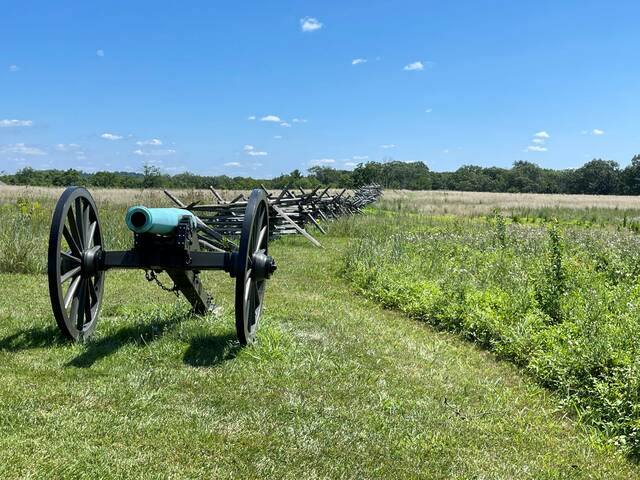
Atop the State of Pennsylvania Monument, a plaque points the way to significant locations in the distance of Gettysburg National Military Park.
A paved path stretches into the woods behind the museum and visitor center at Gettysburg National Military Park in Pennsylvania. It’s shaded with trees and lined with wildflowers and markers pointing the way to Soldiers’ National Cemetery, Meade’s Headquarters, monuments and other significant sites located throughout the 6,000-acre grounds.
Our family has been twice, most recently this time last summer. And I’m realistic: understanding the magnitude of the significance of this iconic, hallowed ground where so many sacrifices were made and lives were lost can’t really be the goal. Instead, I look for a sense of appreciation. Appreciation for what happened, but more importantly, appreciation for the individuals impacted by the sobering events of the Civil War, July 1863.
Right away, our path opens up to a series of memorials, monuments erected by and dedicated to various groups.
A soldier riding a horse is carved into the face of the stone erected by the State of Ohio for the Sixth Ohio Cavalry. Along the side, principal engagements are engraved. New York has also commissioned several. Other states and groups have plaques and statues as well.
After walking for some time, we reach the State of Pennsylvania Monument. It stretches 110 feet high, and is the largest monument on the Gettysburg Battlefield. Four towers support the arches and domes.
The monument commemorates, with tablets and plaques, the names of over 34,530 Pennsylvanians who fought in the war. Eight statues, two on each side of the monument, honor instrumental leaders, including Abraham Lincoln. Made from the brass of melted cannons, The Goddess of Victory and Peace statue crowns the dome.
After climbing the stairs of the pedestal base, our family heads for the spiral staircase located in the northeast column. It opens to an observation deck with an incredible view of the surrounding park.
On the railing, an arrow-clad brass marker points the way to various locations in the distance: Hanover (14 miles), Westminster (26 miles), Baltimore (54 miles), Taneytown (14 miles), Washington (69 miles) and Fredrick (32 miles). Another marker indicates High Water Mark, General George Meade’s Headquarters, Culp’s Hill, Wolfe’s Hill and East Cavalry Field.
From the perspective of this deck, under the cloud-dotted blue sky, fields of green mix with that of beige, blanketing the horizon. Scattered seemingly randomly are small trees. But mostly, one sees additional memorials and monuments. Both lavish and humble obelisks. Pillars topped with statues. And simple rectangular markers.
From this monument, we make our way along the roadside, getting a closer look at the memorials we’d just viewed from the distance.
Although our family covered only a few acres of Gettysburg National Military Park that day, I feel confident in saying we grew from the contemplative experience. And from the tangible memorials, we grew in appreciation for the sacrifices made by others.
–
(Note: Marjorie Appelman is an English, communications and journalism teacher at Mason County High School and co-founder of the travel blog, Tales from the Trip, which is on Twitter, Instagram and Facebook. She can be reached at marj.appelman@gmail.com.)









